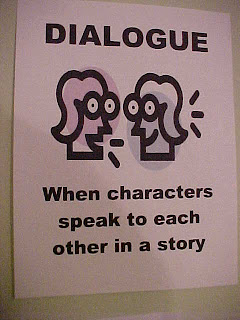Week of May 1—He Said, She Said—Dialogue in Picture Books
Monday, May 2—Dialogue Rules
I spend a lot of time talking about breaking the picture book rules and I often question if the rules we’re breaking are actually rules to begin with. But when it comes to punctuation, breaking the rules is not considered being creative. At best, it’s considered being uninformed. The editor and teacher in me wants to make certain no one stays uniformed!
I have a couple of dialogue posters up for my students. Mind you, my students are fourth graders.
My dialogue rules poster is a good, basic beginning point. If you’ll do this much, you’ll be good to go. But let me delve a little deeper into dialogue rules so the bases are covered.
1. Indent for each new speaker.
(New speaker = New paragraph)
“What time is it?” asked Frank.
“Time to go,” Mavis answered.
2. Only put the words of the speaker inside the quotation marks.
3. Quotation marks always come in pairs.
4. Punctuation always goes inside the quotation marks.
5. Words used to identify the speaker are called tag lines or dialogue tabs.
6. There are four ways to write tag/dialogue tags.
Before the quote:
Mary screamed, “Help me, please!”
Note: The comma always follows the tag line.
After the quote:
“What do you think we should do?” Arthur asked.
“That’s a good question,” said Mary Lou.
Note: If the sentence would normally end with a period, use a comma inside the punctuation marks. If the sentence is a question, use the question mark inside the punctuation marks.
In the middle between two sentences:
“We’ll leave soon,” Mother said. “Be ready to go.”
Note: A period follows the tag line and the beginning of the second sentence/quote is captialized.
In the middle when the tag line splits the quote into two parts:
“We hurried to the cafeteria,” Minnie began, “but we were too late.”
Note: A comma follows the first part of the quote inside the quotation marks, a comma follows the tag line, new quotation marks open, and the sentence continues with a lower case letter.
7. Once the speakers have been identified, tags lines are not always needed.
“You are afraid of everything,” said Tom.
“Not everything,” I answered.
“Yes, everything.”
“Ok, you’re right,” I finally agreed.
Note: This rule helps to break up the redundancy of he said/she said. But be careful. Be certain the reader can understand who is speaking.
Now, that you know the rules, I will admit that some authors break them. In her book, Sweet Tooth, Margie Palatini puts the dialogue of the tooth in boldface print without a tag line.
“It’s over for you tooth,” announced Stewart defiantly, lifting the carrot above his head.
“What are you going to do with that?” asked his wide-eyed sister. Stewart grinned. He opened his mouth wide. Very wide.
“Kid! No! Not the carrot! Not the carrot!”
“Yes. The carrot!” shouted Stewart.
“No, Kid, no!”
Allison covered her eyes.
Closer. Closer. Closer. And then—CR-CR-CRUNCH.
In Saturdays and Teacakes, Lester L. Laminack puts all of the dialogue of his Grandmother (Mammaw) in italics. Some of my writing nerd friends speculate Laminack did this to show this is a memory. But we all have seen many memoirs and stories in past tense that didn’t follow this format. This was just Laminack’s (and his editor’s) preference. Here’s an excerpt:
Then before long Mammaw said, We best clear these dishes away and get at that yard before it gets too hot.
I followed her out to the back porch. Let me put a little water on these ferns, she said. You got on ahead to the car house. (That’s what Mammaw called the garage.) I’ll be out directly.
It’s Your Turn!
1. Choose one of your favorite picture books and type out the text. As you do so, pay attention to the use of dialogue and the dialogue rules used.



1 comment:
Thank you for clarifying this easy outline for dialogue. But I have a question someone told me that when she was reading my manuscript that when you start a new dialogue that the dialogue tag should be in the front of the sentence that the person is speaking and that’s a rule in picture books. I’ve never heard of that before and mine are usually sometimes before or after the person speaking.
Post a Comment